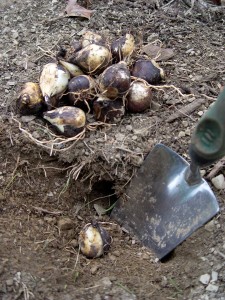October

October is prime time for planting spring bulbs.
- Best month to plant tulips, daffodils, hyacinths, crocuses and other spring-flowering bulbs. Pot up some to force for indoor winter bloom.
- Replace annuals with pansies, mums, ornamental cabbage/kale or other fall or cool-season plants — in pots as well as beds.
- Plant new trees, shrubs and perennials.
- Divide existing perennials, except fall-blooming ones, and transplant existing shrubs.
- As frost browns perennial foliage, prune it to the ground, except for mums, sedum, ornamental grasses and plants with seeds that you want to leave for birds (i.e. coneflowers and black-eyed susans).
- Stop pruning and fertilizing trees and shrubs as they head into dormancy.
- Feed the lawn one last time late in the month or early November. Add lime if soil test indicates.
- It’s still OK to dethatch or aerate the lawn if you didn’t do it in September. Get grass seed down by the end of the month.
- Grub damage on the lawn? It’s getting late to effectively kill grubs, plus damage will taper off shortly. Best use of your time and money now is on reseeding the dead spots.
- Clean up the vegetable garden. Discard any bug-infested or diseased material, harvest everything but the freeze-tolerant fall crops and top the cleared beds with an inch of compost.
- Rake leaves off the lawn if they’re too thick to mow. Also rake leaves off of evergreen groundcovers. Use the leaves in your compost (they’re ideal mixed with year-end grass clips and yanked garden plants) or chop them and spread over the bare veggie and annual beds.
- Small to moderate amounts of leaves on lawns can be run over with a mower. Let the grass/leaf mix on the lawn unless it’s enough to threaten to mat down the grass. Rake up these channels and compost or use as mulch on the veggie and annual beds.
- Great time to start a compost pile if you don’t already have one or two or three.
- Do NOT rake leaves out of shrub and perennial beds. They make good winter insulation and can be mulched on top of in spring, unless they’re more than 2 inches thick.
- Dig tender bulbs, trim foliage, dry and store inside for winter.
- Dig and repot herbs or selected annuals (i.e. coleus, impatiens, begonias or fuchsia) for growing inside. You may be able to convert many pot centerpieces into houseplants, salvaging these for another season outside next year.
- Dig new beds and/or improve the soil in existing beds. The weather is cool and the soil is usually drier now than early spring.
- Get those houseplants back inside ASAP if you didn’t do it last month. Even distant brushes with frost is enough to kill off some tender varieties. Check for insects and hose down or treat with insecticides, if needed.
- Monitor for the last of the season’s pests and treat as needed. Watch for spruce gall adelgids on spruce and Douglas fir; woolly adelgids on hemlocks, and spider mites on spruce and other evergreens.
- Protect roses from cold weather by using rose cones or mounding mulch a few inches up against the stems. Cut back long canes to about 4 feet.
- Secure a net over the water garden to keep falling leaves out.
- Feed fish as long as they’re active. Switch to cold-weather fish food.
- After frost, cut aquatic plants off at about 3 inches and submerge pots at the bottom of the pond for winter. Remove or store tropicals. An indoor water garden is a good way to keep tender aquatic plants alive over the winter.
- Disconnect and drain water-garden pumps and filters. Add pond heater or bubbler stone to allow oxygen hole for fish when water freezes.
- Pull or spot-spray late-season weeds in the lawn and gardens.
- Take hardwood cuttings of shrubs you want to propagate.
- Keep plants well watered – especially newly planted plants – if the October is dry. We sometimes get sneaky fall droughts.







